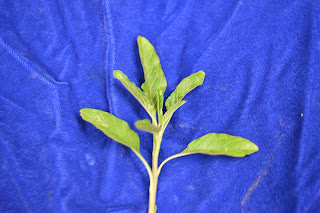When dealing with a plant sample, the
first step is generally to determine the causal agent of the problem: abiotic factor, fungi, bacteria, or a virus. Once this is determined,
each agent has a different method of approach. Today we will be dealing with a
bacterial pathogen, so the first step is going to be the search for the
illustrious bacterial ooze. Plant pathogenic
bacteria have an interesting property in that they will “ooze” out of tissue
when sliced. With a large enough (and well infected) sample, this can
actually be seen in a beaker or glass of water. With a smaller sample, a small
section of infected tissue is sliced, preferably at a transition zone, and then
mounted onto a slide. Under the scope, along the edges of the cut tissue,
bacteria can be seen streaming out in what can be best described as a mist or a
cloud. Once this is found, we can move onto the next step, the best step, the
culturing step.
Bacterial ooze!
The transition zones mentioned
previously are next going to be used to make up our nasty and kind of creamy
bacterial broth. These zones are selected, cut, and then surface sterilized
with a quick dip in a 10% bleach solution. Following this is a quick dip in
distilled water, they are then left to dry in the crease of a paper towel
in our flow hood. Once air dried the sample material is placed in a test tube
of sterile water, shaken up, and left to sit for at least 30 minutes. This is
when the bacteria start streaming out into the water, making what can be best
described as a “broth” of bacteria. This nasty little tube of liquid is what
will be used to culture out our bacteria.
In this case, we suspect a Pseudomonas bacteria, so we have chosen Kings B or Pseudomonas Agar. This medium is pretty cool
in that most bacteria will grow just fine on it, but if a Pseudomonas bacteria
is cultured on it. This agar will glow under UV or blacklight, once there has been
adequate bacterial growth. The Plant Clinic cultures its bacteria in two ways, either by
spread plates or streak plates. Both techniques are quite easy, with each
having its own benefits. In one technique, an inoculating loop (a
small wire loop) is used to grab a droplet of bacteria solution which is then “streaked”
over the agar plate. The other technique
is called a spread plate. In this a larger amount of the liquid bacteria
solution, 1/10 of a mL, is pipetted onto the plate. A bent glass rod is then
used to “spread” it evenly over the surface of the media.
Hopefully you found this quick look
behind the scenes at the U of I Plant Clinic to be informative (and hopefully somewhat
interesting too).
















